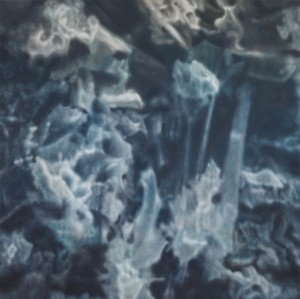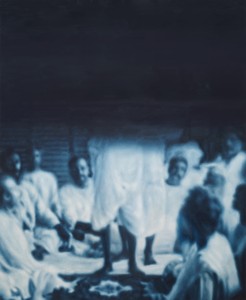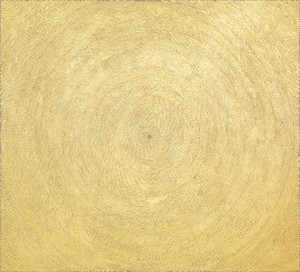
In Conversation
Setsuko and Y.Z. Kami
The artists address their shared ardor for poetry, the surfaces of painting, and nature.
Gagosian is pleased to announce The Domes, an exhibition of paintings by Y.Z. Kami, opening on June 28. The presentation brings together two bodies of work by the artist: a survey of Dome paintings made from 2011 to the present, and a group of new Messenger paintings. The exhibition marks a meaningful return to the West Coast for Kami—he spent his early years in Northern California after moving to the United States from Tehran in 1973, and Southern California has played host to a number of his institutional presentations, including a solo exhibition at the Los Angeles County Museum of Art nearly a decade ago.
The Dome paintings interpret architectural structures as painted form, their tessellated rectangles and squares arrayed in concentric rings of white, blue, black, or gold. In some works, Kami additionally creates radiant mosaiclike squares that converge at the compositions’ centers. Abstracting the experience of gazing up into luminous hemispheres, these paintings evoke the domes of temples, churches, and mosques—technical triumphs of construction that span enormous light-filled spaces to signify the heavens.
Eliminating spatial perspective, the Dome paintings function as mandalas, meditative designs that aspire to infinity. Additionally, their palettes correspond to the four stages of material and symbolic transmutation of elements in the tradition of alchemy. These works emerged from Kami’s consideration of sacred architecture in Untitled (Diptych) (1996), which was featured in the exhibition Architecture as Metaphor at the Museum of Modern Art, New York, in 1997. This pair of large-scale photographic prints mounted on canvas juxtaposes two Persian domes to form a spatial vortex. Kami developed the motif of concentric circles further with Rumi, The Book of Shams E Tabrizi (In Memory of Mahin Tajadod) (2005), a sculpture of soapstone blocks imprinted with verses by the Persian poet Rumi, and with his series of Endless Prayer collages and paintings (initiated in 2005).
Gagosian
press@gagosian.com
Hallie Freer
hfreer@gagosian.com
+1 212 744 2313
Request more information
about this exhibition

The artists address their shared ardor for poetry, the surfaces of painting, and nature.
Y.Z. Kami and curator Steven Henry Madoff sit down in Kami’s studio to discuss the artist’s exhibition at the Museo de Arte Contemporáneo de Castilla y León, Spain. Entitled Y.Z. Kami: De forma silenciosa/In a Silent Way, the survey features portraits; images of buildings, both sacred and ordinary; a sculptural installation of loose bricks inscribed with texts; and recent dreamlike abstractions.

In celebration of the release of the monograph Y.Z. Kami: Works 1985–2018, and in advance of an exhibition of new works by the artist at Gagosian, Rome, Ziba Ardalan and Elena Geuna sat down to discuss Y.Z. Kami’s work. The conversation was moderated by Gagosian’s Kay Pallister.

An exhibition at Gagosian, Paris, is raising funds to aid in the reconstruction of the Cathédrale Notre-Dame de Paris following the devastating fire of April 2019. Gagosian directors Serena Cattaneo Adorno and Jean-Olivier Després spoke to Jennifer Knox White about the generous response of artists and others, and what the restoration of this iconic structure means across the world.

Elena Geuna interviews the artist on the subjects of his childhood, his approach to portraiture, and the centrality of light in his practice.

The Summer 2019 issue of Gagosian Quarterly is now available, featuring a detail from Afrylic by Ellen Gallagher on its cover.

Blaise Pascal, the seventeenth-century mathematician and philosopher, served as a crucial inspiration for Y.Z. Kami’s newest body of work. Angela Brown examines Pascal’s ideas and their relevance to these portraits and Dome paintings.

Y.Z. Kami and Peter Marino discuss the power of bronze, the current state of architecture, and the infinite.

During preparations for an exhibition in London, Y.Z. Kami met with Gagosian’s Alison McDonald to discuss the evolution of his work, technique, and his combination of influences.